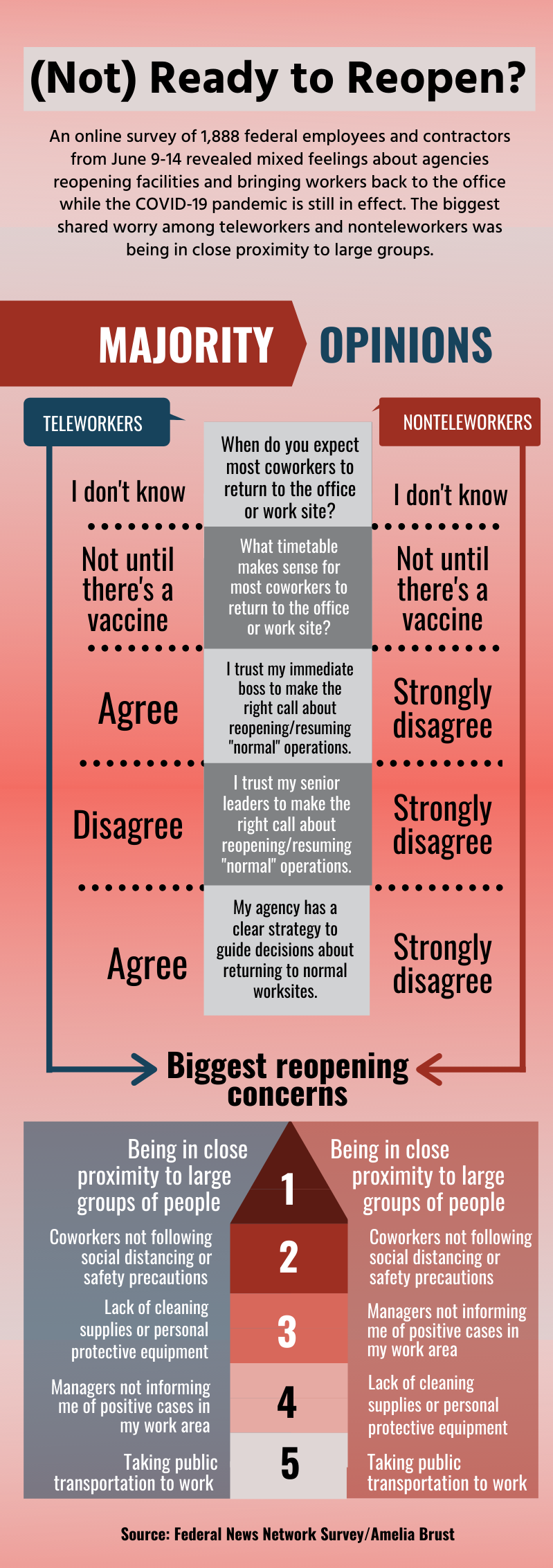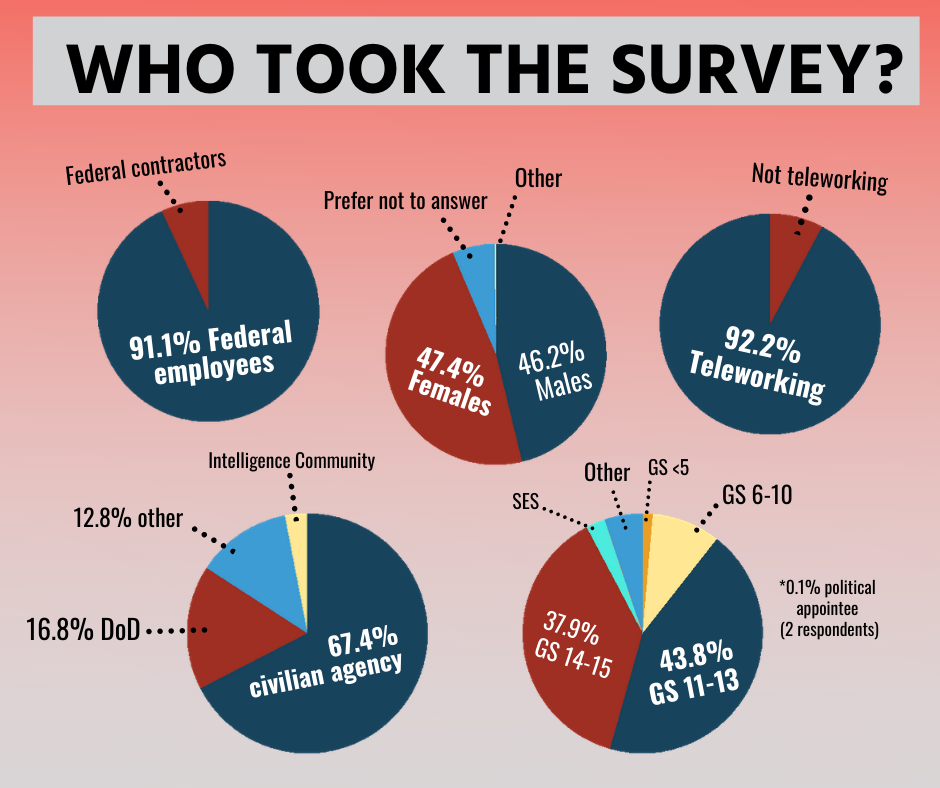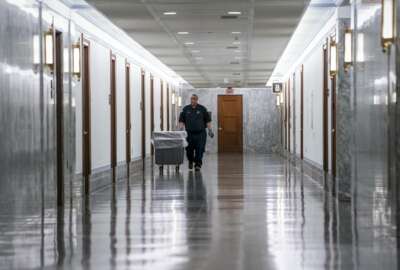Data Dive
After months of telework, most feds are uncomfortable with returning to the office
Roughly 85% of federal teleworkers said they were uncomfortable with the prospects of returning to the office after three months of remote work, according to a...
Few federal employees are eager to return or join large swaths of their co-workers back at the office, especially as large-scale telework — despite some initial hiccups — has proven to be relatively effective during the coronavirus pandemic.
A recent Federal News Network survey found the vast majority of those still working from home have some level of discomfort about returning to the office in accordance with their agencies’ reopening plans.
According to the survey results, 60% of employees and contractors who are still teleworking are “very uncomfortable” with the prospect of returning to the federal work site. An additional 15% said they were “slightly uncomfortable” with returning.
Just 15% of survey respondents said they were “very comfortable” or “relatively comfortable” with the idea of returning to the office.
“I will remain very uncomfortable until infection rates are legitimately under control or eradicated,” one respondent said. “If that means we don’t go back to the office until next calendar year, so be it. We have proven 100% telework works, so why rush it when employee health is on the line?”
For those who are working at the office or work site, employees are nearly split on the prospect of their co-workers returning.
Nearly 31% of non-teleworking federal employees said they were very uncomfortable with their co-workers returning to the office, but 26% said they were very comfortable with the idea. A total of 42% said they were relatively comfortable or slightly uncomfortable with their co-workers returning, with respondents evenly split between the two options. 
Some 1,888 federal employees and contractors took the survey; the majority were GS-11-15s.
This isn’t necessarily a representative sample of the entire federal workforce and their views about reopening, as participants self-selected to take this survey.
During the five days the survey was open in mid-June, the vast majority of respondents — about 92% — were still teleworking. The remaining 8% of respondents were never eligible to telework, didn’t want to work remotely or recently returned to the office after teleworking for a portion of the pandemic.
For both teleworkers and non-teleworkers, being in close or near proximity to larger groups of people is their number one concern about resuming “more normal” operations at the work site.
“I can’t control the hygiene of others in the workforce, but I know the habits of my family and trust it is a safe environment to work in,” one respondent wrote. “Having lived in New York City through this scourge and lost a loved one, I don’t want to go through this again.”
Co-workers failing to follow social distancing guidelines or other safety precautions was a second top worry, though several respondents expressed concern with the tightly-packed, low-walled cubicles in their offices.
“The environment is too open [with] shared desks, conference rooms, etc.,” another respondent said. “In open space there is nothing protecting you and you don’t have a dedicated seat. Seating is first come first serve.”
In contrast, one respondent expressed confidence in the safety precautions his government-owned, contractor-operated laboratory would take.
“Throughout, from the top down, it has used an evidence-driven approach and has taken the high road in employee relations,” the respondent wrote. “As they dip their toe into the water on re-opening — in a phased approach that emphasizes social distancing and hygiene — I have confidence that they are strenuously following best practices, and that work — when I am allowed back — will be the safest place I can go other than my own home.”
For others, the office is the last place that seems safe.
“I cannot see how it can possibly work when everyone returns to the office. We have two elevators serving a building with almost 200 employees,” one respondent said. “The new social-distancing markings in the elevators indicate that only two people can ride in an elevator at once. Furthermore, we’re required to stand back six feet from the elevators while waiting for one. The elevator lobby is small, and there’s only room for three people, max, standing six feet apart. Up until this week, masks, gloves and disinfectant wipes weren’t even available. The restrooms, break areas, copiers, etc. are all shared by a large number of people, with no practical way to disinfect them between uses.”
Many employees noted they were high risk — either because of a health condition or their age — for the virus, another factor that made them anxious about surrounding themselves with more people again. The most recent data available from the Office of Personnel Management shows 43% of the federal workforce is age 50 or older, including 14% who are over the age of 60.
Using public transportation was another concern, though respondents ranked it last among five options.
“I used to slug into the Pentagon; that has effectively disappeared as an option probably forever,” one respondent said. “Now when I come in I have to drive, which is expensive, time consuming and frustrating. [There’s] nowhere near enough parking if everyone is going to have to drive.”
When does it make sense to return?
Among teleworkers, a small majority — about 40% of respondents — want to wait until there’s an effective coronavirus vaccine before returning to the office.
“We should return to work when it is safe, not because of political pressure,” one employee said. “When productivity is equal to or better than being in the office, there is zero reason for going back to the office, ever, until a vaccine is available and infection rate is close to none.”
A quarter of teleworking respondents prefer not to go back to the office at all and continue remote work indefinitely. For 28%, returning to the office sometime in the next four months seems most appropriate.
Roughly 5%, however said federal employees should return to their offices as soon as possible.
“It is past time,” one person said. “All the latest news on the virus shows it wasn’t the threat most people, including experts, thought it was back in late March or early April. This data should be the driving factor in restoring America back to what it was in February.”
“The offices have to open sometime,” another respondent said. “Prolonging opening will cause more problems. The public is getting impatient about not getting services that the government has to help them.”
Non-teleworkers offered far more mixed views on when it made sense for their co-workers to join them at the work site. The slightest majority, about 26% of non-teleworkers, said their co-workers shouldn’t return until an effective vaccine was available. Another 22% said it made sense for their co-workers to return in a month or two.
“Our internal polls suggest that about half of staff are eager to get back to the office, and half have serious reservations or worries about going back to the office,” one respondent said. “This tension will be difficult to manage.”
Trust in agency leadership on reopening lags
Both teleworkers and non-teleworkers offered mixed views on their agency’s leaders.
Nearly 44% of respondents agreed their immediate supervisors would do the right thing in reopening and bringing employees back to the work site, compared with 33% who disagreed. The remaining 23% of respondents were neutral.
“I don’t think anyone knows what’s best; they just have to follow guidelines,” one respondent said. “However, I feel it’s too risky to send employees back to the office, especially since we’ve done a great job — seamless — since we’ve all had to telework during the past three months.”
Trust in senior leadership, however, is a different story. 
Nearly half — or 48% of all respondents — said they didn’t believe their agency’s top leaders would make the right call about reopening or resuming “normal” operations. About 30% said they did trust their senior leadership, while another 23% were neutral.
Many said they believed their agencies were under political pressure to reopen quickly, with several respondents citing their leaders’ negative views on telework.
“I believe my immediate supervisors, who have good sense about things, could easily find themselves in a situation where they are being told, not asked, about next steps,” one respondent said. “My agency had dropped telework to one day a week literally the week before we began 100% telework. This was because of a lack of metrics — but primarily trust — related to employees working from home. My specific department has done outstanding work while we’ve been out — and we are hoping that will help management feel more comfortable extended telework as long as needed.”
Employees and contractors also offered mixed views of their agencies’ reopening plans. About 34% of respondents said their agency had a clearly written and communicated reopening plan, while 37% said they did not. The remaining respondents were neutral or weren’t sure.
“Our administrator has been conducting weekly meetings [and has been] keeping the entire workforce informed with respect to re-opening,” one respondent wrote. “Employees are encouraged to submit questions prior to each meeting and during each meeting.”
Yet many employees and contractors noted their immediate supervisors didn’t have a say in their agency’s approach to reopening, though several plans and messages to the workforce have deferred decisions about telework, reasonable accommodations and flexible work schedules to individual managers.
“Policies and plans state one thing,” one respondent wrote. “Actual implementation and actions are showing to be completely different than what is written.”
Copyright © 2025 Federal News Network. All rights reserved. This website is not intended for users located within the European Economic Area.
Nicole Ogrysko is a reporter for Federal News Network focusing on the federal workforce and federal pay and benefits.
Follow @nogryskoWFED
Related Stories





